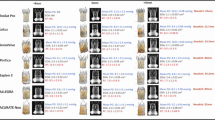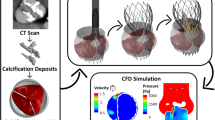Abstract
Transcatheter aortic valve implantation (TAVI) is currently recommended in practice guidelines for patients who are at intermediate to high surgical risk for surgical aortic valve replacement. Coronary artery obstruction is a fatal complication of TAVI that occurs in up to 3.5% of the implantations inside a failed surgical bioprosthetic valve (valve-in-valve, ViV). A new technique to address this problem is intentional laceration of the bioprosthetic leaflets, known as BASILICA. In this technique, the leaflets are lacerated to prevent coronary obstruction and may also help in preventing leaflet thrombosis. Our hypothesis is that this technique may harm the circumferential stress in the surgical valve and weaken the anchorage of the TAVI device. This study aims to compare the anchorage post-ViV implantations, with and without lacerations, using numerical modelling. Deployments of TAVI stents (Medtronic Evolut PRO; Edwards SAPIEN 3) inside an externally mounted surgical bioprosthetic valve (Sorin Mitroflow) were modelled by finite element analysis. The results show that each laceration reduces the contact area of the TAVI stent with its landing zone and that the anchorage contact force weakens. The BASILICA technique has lesser effect on the anchorage contact area and forces in the SAPIEN than in the Evolut cases, because the balloon inflation is less sensitive to the deployment region. TAVI stent migration was not found in any of the models. These results can help expanding the use of leaflet laceration by choosing a better matched TAVI devices for the BASILICA technique.







Similar content being viewed by others
References
Avanzini A, Battini D (2014) Structural analysis of a stented pericardial heart valve with leaflets mounted externally. Proc Inst Mech Eng H 228:985–995. https://doi.org/10.1177/0954411914552309
Bailey J, Curzen N, Bressloff NW (2016) Assessing the impact of including leaflets in the simulation of TAVI deployment into a patient-specific aortic root. Comput Methods Biomech Biomed Eng 19:733–744. https://doi.org/10.1080/10255842.2015.1058928
Bakaeen FG, Rosengart TK, Carabello BA (2017) Aortic stenosis. Ann Intern Med 166:Itc1–Itc16. https://doi.org/10.7326/aitc201701030
Bapat V (2014) Valve-in-valve apps: why and how they were developed and how to use them. EuroIntervention 10(U):U44–U51. https://doi.org/10.4244/eijv10sua7
Bianchi M, Marom G, Ghosh RP, Fernandez HA, Taylor JR Jr, Slepian MJ, Bluestein D (2016) Effect of balloon-expandable transcatheter aortic valve replacement positioning: a patient-specific numerical model. Artif Organs 40:E292–E304. https://doi.org/10.1111/aor.12806
Bianchi M, Marom G, Ghosh RP, Rotman OM, Parikh P, Gruberg L, Bluestein D (2019) Patient-specific simulation of transcatheter aortic valve replacement: impact of deployment options on paravalvular leakage. Biomech Model Mechanobiol 18:435–451. https://doi.org/10.1007/s10237-018-1094-8
Bosi GM, Capelli C, Cheang MH, Delahunty N, Mullen M, Taylor AM, Schievano S (2018) Population-specific material properties of the implantation site for transcatheter aortic valve replacement finite element simulations. J Biomech 71:236–244. https://doi.org/10.1016/j.jbiomech.2018.02.017
Capelli C et al (2012) Patient-specific simulations of transcatheter aortic valve stent implantation. Med Biol Eng Comput 50:183–192. https://doi.org/10.1007/s11517-012-0864-1
Cheung AW, Ye J, Dvir D, Wood DA, Webb JG (2018) Aortic valve-in-valve in externally mounted bioprosthesis: a safe treatment option for bioprosthetic structural valve dysfunction. Innovations 13:171–176. https://doi.org/10.1097/IMI.0000000000000500
Dąbrowski M, Finkelstein A, Witkowski A (2017) Transcatheter aortic valve implantation. Kardiol Pol 75:837–844
Dvir D et al (2015) Coronary obstruction in transcatheter aortic valve-in-valve implantation: preprocedural evaluation, device selection, protection, and treatment. Circ Cardiovasc Interv 8:e002079. https://doi.org/10.1161/CIRCINTERVENTIONS.114.002079
Dvir D et al (2018) Novel strategies in aortic valve-in-valve therapy including bioprosthetic valve fracture and BASILICA. EuroIntervention 14:AB74–AB82. https://doi.org/10.4244/eij-d-18-00667
Edwards MB, Ordidge RJ, Thomas DL, Hand JW, Taylor KM (2002) Translational and rotational forces on heart valve prostheses subjected ex vivo to a 4.7-T MR system. J Magn Reson Imaging 16:653–659. https://doi.org/10.1002/jmri.10201
Hatoum H, Maureira P, Lilly S, Dasi LP (2019) Leaflet laceration to improve neosinus and sinus flow after valve-in-valve. Circ Cardiovasc Interv 12:e007739. https://doi.org/10.1161/CIRCINTERVENTIONS.118.007739
Khan JM et al (2018) Transcatheter laceration of aortic leaflets to prevent coronary obstruction during transcatheter aortic valve replacement: concept to first-in-human. J Am Coll Cardiol Interv 11:677–689. https://doi.org/10.1016/j.jcin.2018.01.247
Khodaee F, Qiu D, Dvir D, Azadani AN (2019) Reducing the risk of leaflet thrombosis in transcatheter aortic valve-in-valve implantation by BASILICA: a computational simulation study. EuroIntervention 15:67–70. https://doi.org/10.4244/EIJ-D-19-00048
Landes U, Kornowski R (2017) Transcatheter valve implantation in degenerated bioprosthetic surgical valves (ViV) in aortic, mitral, and tricuspid positions: a review. Struct Heart 1:225–235. https://doi.org/10.1080/24748706.2017.1372649
Lanz J, Pilgrim T, Greenbaum AB, Windecker S (2018) Bioprosthetic aortic scallop intentional laceration to prevent iatrogenic coronary artery obstruction (BASILICA) during transcatheter aortic valve-in-valve implantation with bioprosthetic valve fracturing via the transcaval access. EuroIntervention 14:884–885. https://doi.org/10.4244/EIJ-D-18-00553
Lootens L et al (2017) Ten-year results of aortic valve replacement with first-generation mitroflow bioprosthesis: is early degeneration a structural or a technical issue? Eur J Cardio-Thorac Surg 52:272–278. https://doi.org/10.1093/ejcts/ezx117
Makkar RR et al (2015) Possible subclinical leaflet thrombosis in bioprosthetic aortic valves. N Engl J Med 373:2015–2024. https://doi.org/10.1056/NEJMoa1509233
McGee OM, Gunning PS, McNamara A, McNamara LM (2019) The impact of implantation depth of the lotus valve on mechanical stress in close proximity to the bundle of his. Biomech Model Mechanobiol 18:79–88. https://doi.org/10.1007/s10237-018-1069-9
Midha PA et al (2015) How can we help a patient with a small failing bioprosthesis? An in vitro case study. J Am Coll Cardiol Interv 8:2026–2033. https://doi.org/10.1016/j.jcin.2015.08.028
Midha PA et al (2016) Valve type, size, and deployment location affect hemodynamics in an in vitro valve-in-valve model. J Am Coll Cardiol Interv 9:1618–1628. https://doi.org/10.1016/j.jcin.2016.05.030
Morganti S, Brambilla N, Petronio AS, Reali A, Bedogni F, Auricchio F (2016) Prediction of patient-specific post-operative outcomes of tavi procedure: the impact of the positioning strategy on valve performance. J Biomech 49:2513–2519. https://doi.org/10.1016/j.jbiomech.2015.10.048
Mosquera VX et al (2018) Efficacy and safety of transcatheter valve-in-valve replacement for mitroflow bioprosthetic valve dysfunction. J Card Surg 33:356–362. https://doi.org/10.1111/jocs.13720
Nalluri N et al (2018) Valve in valve transcatheter aortic valve implantation (viv-tavi) versus redo-surgical aortic valve replacement (redo-savr): a systematic review and meta-analysis. J Interv Cardiol 31:661–671. https://doi.org/10.1111/joic.12520
Nelson BC, Chadderdon S, Song H, Zahr FE (2019) Bioprosthetic aortic valve leaflet disruption with high energy electrocautery to prevent coronary artery obstruction during valve-in-valve transcatheter aortic valve replacement. Catheter Cardiovasc Interv 93:164–168. https://doi.org/10.1002/ccd.27721
Otto CM, Prendergast B (2014) Aortic-valve stenosis—from patients at risk to severe valve obstruction. N Eng J Med 371:744–756. https://doi.org/10.1056/NEJMra1313875
Sacks MS (2000) Biaxial mechanical evaluation of planar biological materials. J Elast Phys Sci Solid 61:199–246. https://doi.org/10.1023/A:1010917028671
Simonato M, Dvir D (2019) Transcatheter aortic valve replacement in failed surgical valves. Heart 105:s38–s43. https://doi.org/10.1136/heartjnl-2018-313517
Sturla F et al (2016) Impact of different aortic valve calcification patterns on the outcome of transcatheter aortic valve implantation: a finite element study. J Biomech 49:2520–2530. https://doi.org/10.1016/j.jbiomech.2016.03.036
Tzamtzis S, Viquerat J, Yap J, Mullen MJ, Burriesci G (2013) Numerical analysis of the radial force produced by the Medtronic-Corevalve and Edwards-Sapien after transcatheter aortic valve implantation (TAVI). Med Eng Phys 35:125–130. https://doi.org/10.1016/j.medengphy.2012.04.009
Wang Q, Sirois E, Sun W (2012) Patient-specific modeling of biomechanical interaction in transcatheter aortic valve deployment. J Biomech 45:1965–1971. https://doi.org/10.1016/j.jbiomech.2012.05.008
Wang Q, Kodali S, Primiano C, Sun W (2015) Simulations of transcatheter aortic valve implantation: implications for aortic root rupture. Biomech Model Mechanobiol 14:29–38. https://doi.org/10.1007/s10237-014-0583-7
Funding
This work was partially supported by a Grant from the Nicholas and Elizabeth Slezak Super Centre for Cardiac Research and Biomedical Engineering at Tel Aviv University.
Author information
Authors and Affiliations
Corresponding author
Ethics declarations
Conflict of interest
Prof Finkelstein serves as a proctor, advisor and speaker for both Medtronic Inc. and Edwards Lifesciences. The remaining authors declare that they have no conflict of interest.
Additional information
Publisher's Note
Springer Nature remains neutral with regard to jurisdictional claims in published maps and institutional affiliations.
Electronic supplementary material
Below is the link to the electronic supplementary material.
Rights and permissions
About this article
Cite this article
Yaakobovich, H., Plitman Mayo, R., Zaretsky, U. et al. Numerical models of valve-in-valve implantation: effect of intentional leaflet laceration on the anchorage. Biomech Model Mechanobiol 19, 415–426 (2020). https://doi.org/10.1007/s10237-019-01218-1
Received:
Accepted:
Published:
Issue Date:
DOI: https://doi.org/10.1007/s10237-019-01218-1




